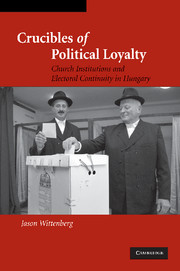Book contents
- Frontmatter
- Contents
- List of Figures
- List of Tables
- Acknowledgments
- INTRODUCTION
- 1 EXPLAINING POLITICAL PERSISTENCE
- 2 ELECTORAL PERSISTENCE AND VOLATILITY IN HUNGARY
- 3 THE CHURCHES FIRST CONFRONT COMMUNISM
- 4 THE BATTLE FOR SOULS, 1948–1956
- 5 THE BATTLE FOR SOULS AFTER 1956
- 6 CHURCH COMMUNITY AND RIGHTIST PERSISTENCE: STATISTICAL EVIDENCE
- 7 CONCLUSION
- Appendices
- Bibliography
- Index
- Titles in the series
3 - THE CHURCHES FIRST CONFRONT COMMUNISM
Published online by Cambridge University Press: 02 September 2009
- Frontmatter
- Contents
- List of Figures
- List of Tables
- Acknowledgments
- INTRODUCTION
- 1 EXPLAINING POLITICAL PERSISTENCE
- 2 ELECTORAL PERSISTENCE AND VOLATILITY IN HUNGARY
- 3 THE CHURCHES FIRST CONFRONT COMMUNISM
- 4 THE BATTLE FOR SOULS, 1948–1956
- 5 THE BATTLE FOR SOULS AFTER 1956
- 6 CHURCH COMMUNITY AND RIGHTIST PERSISTENCE: STATISTICAL EVIDENCE
- 7 CONCLUSION
- Appendices
- Bibliography
- Index
- Titles in the series
Summary
Introduction
We now explore the Churches' role in providing an arena for resisting the Party's efforts to remake partisanship in society. Any retelling of the battle between Church and State under state-socialism should begin with a picture of the reservoir of support and tools each could call upon as the struggle began. Chapter 2 briefly discussed the communist movement; here we begin by summarizing the cultural, economic, political, and spiritual influence of the Churches in society in the years preceding the communist takeover. The purpose is not to provide a comprehensive account of Church-State relations, but rather to highlight the deep roots the Churches had in Hungarian society. The chapter then chronicles the dramatic diminution of the Churches' institutional presence between the end of World War II and the early years of the Stalinist regime. I focus in particular on the strategies the regime employed both to shrink the Churches and to harness what remained to the service of socialism. The Party's newly erected institutions of surveillance and control will serve as the backdrop for the discussion of the local struggles for mass loyalty in Chapters 4 and 5.
The Churches before State-Socialism
Roman Catholicism became the official religion of Hungary in 1000 a.d., when King Stephen received his crown from Pope Sylvester II. For nearly six centuries, Catholicism reigned supreme, enjoying economic, educational, spiritual, and legal predominance.
- Type
- Chapter
- Information
- Crucibles of Political LoyaltyChurch Institutions and Electoral Continuity in Hungary, pp. 76 - 113Publisher: Cambridge University PressPrint publication year: 2006



